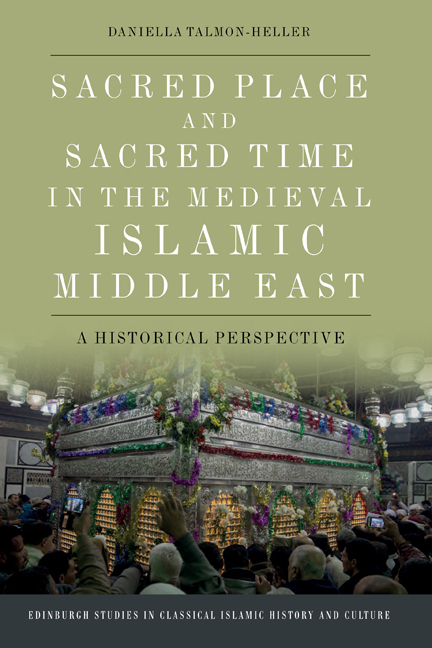Book contents
- Frontmatter
- Contents
- List of Figures
- Acknowledgements
- Map of the Middle East
- Introduction
- 1 Etic Concepts and Emic Terms
- 2 The State of the Art
- Part One A Sacred Place: The Shrine of al-Husayn’s Head
- Part Two A Sacred Time: The Month of Rajab
- Final Comments: Spacial and Temporal Sanctity
- Works Cited
- Index
4 - The Commemoration of al-Husayn in Fatimid Ascalon
Published online by Cambridge University Press: 17 October 2020
- Frontmatter
- Contents
- List of Figures
- Acknowledgements
- Map of the Middle East
- Introduction
- 1 Etic Concepts and Emic Terms
- 2 The State of the Art
- Part One A Sacred Place: The Shrine of al-Husayn’s Head
- Part Two A Sacred Time: The Month of Rajab
- Final Comments: Spacial and Temporal Sanctity
- Works Cited
- Index
Summary
The Fatimids, a Shiʿi Ismaʿili dynasty, claimed direct lineage from the Prophet's daughter Fatima and her son al-Husayn. After proclaiming a new caliphate in 297/909 in North Africa and establishing their seat of government in Mansuriyya near Kairouan in 336/948, their dominion was extended to Egypt in 358/969, and then to most of Syria. The Fatimid Empire lasted, with changing borders, for two and a half centuries. Attempting to balance their Ismaʿili mission with the need to find favour with the caliphate's Sunni majority, the regime adopted a ‘two-tiered approach’. The head of the Fatimid state served in the double capacities of imam and caliph. He was the infallible and absolutely indispensable religious leader for the Shiʿi minority and a political ruler for all his subjects. And while all subjects were granted religious freedom, the Fatimids continuously developped their esoteric doctrine and spread it among the Ismaʿili elite and beyond the borders of their empire.
The prolific Mamluk-era historian al-Maqrizi (766/1364–845/1449) is responsible for much of our knowledge concerning governance and ritual during the Fatimid period in Egypt. Robert Irwin suggests that al-Maqrizi ‘had a passionate and somewhat antiquarian interest in the Fatimids’, whom Sunni authors often shunned, because they were the founders of his beloved city, Cairo. In his Ittiʿāẓ al-Ḥunafāʾ bi-Akhbār al-Aʾimma al-Fāṭimiyyīn al-Khulafāʾ (Lessons for the Seekers of Truth in the History of the Fatimid Imams and Caliphs), al-Maqrizi focuses almost exclusively on this age. Besides preserving significant portions of otherwise non-extant works by his forerunners – such as Ibn Zulaq (d. 386/996), al-Musabbihi (d. 420/1029), Ibn al-Muyassar (d. 677/1278–9) and al-Bataʾihi (d. 588/1192) – al-Maqrizi weaves otherwise lost Fatimid documents, letters and sermons into his own narrative.
The empire's inaugural Friday sermon (khuṭba) in Egypt, as cited by al-Maqrizi, invoked blessings for the imam-caliph al-Muʿizz, who conquered the Land of the Nile, and on ‘his pure forefathers and descendants, the righteous imams’.
- Type
- Chapter
- Information
- Sacred Place and Sacred Time in the Medieval Islamic Middle EastA Historical Perspective, pp. 42 - 54Publisher: Edinburgh University PressPrint publication year: 2020



